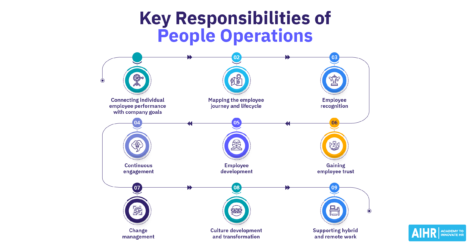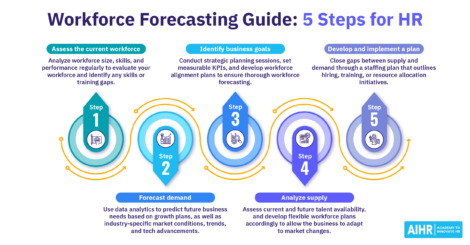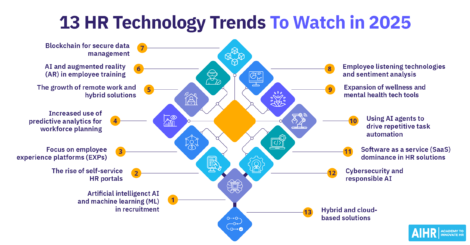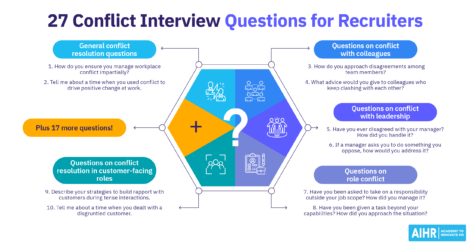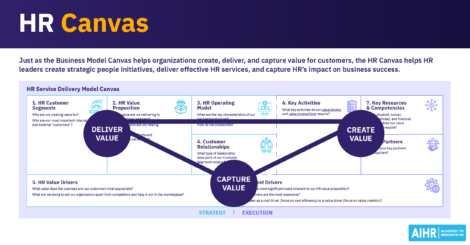29 Common (and Critical) HR Policies to Have in Place in 2025
Driving a vehicle without traffic rules is confusing and hazardous. The workplace is no different. Guidelines and procedures prevent chaos and keep organizations on track.

HR’s role in workplace policies is often misunderstood in a few ways. Some employees see HR as rule enforcers who impose policies without input, while others assume HR exists solely to protect the company, not the workforce. In reality, HR develops policies to balance business needs with employee rights, ensuring fair treatment, compliance with laws, and a safe, productive environment.
A well-defined set of HR policies and practices allows managers and HR to make decisions based on business factors and objective criteria rather than personal reasons, biases, or prejudices. Without clear and transparent policies, there is more potential for misunderstanding and conflict. That’s why every organization must be proactive and prioritize effective HR policy development.
This article explores what HR policies are and why they’re important, and it outlines 29 examples of HR policies that organizations should have in place.
Contents
What are HR policies?
Why are HR policies and procedures important?
HR policy examples
How to write an HR policy
Essential elements of an HR policy
FAQ
What are HR policies?
HR policies are formal, written frameworks that guide how various employment-related issues, challenges, and opportunities should be handled in the workplace. They provide employees with structure and clarity around expectations related to workplace conduct, standards, and parameters. In addition, they help ensure that the company’s workforce is treated consistently while minimizing legal risks.
These guidelines vary by company, industry, state, and country and are typically included in an employee handbook, standard operating procedures, and the company intranet. Since they must be followed by all employees, HR is responsible for ensuring they are communicated effectively and that employees receive proper training.
Each HR policy focuses on a specific topic or area, typically including:
- Description of the subject
- Who the policy applies to (e.g., all employees, part-time, full-time, exempt, non-exempt, etc.)
- General guidance around standards and expectations for managers and employees
- Who oversees the policy administration
- Consequences for policy violations
- Reporting procedures for employees.
HR policies may also include supplemental procedures or detailed steps to clarify expectations and administration. These rules are not intended to be punitive but to support the company’s overall HR strategic vision.
Developing HR policies is often a collaborative effort between Human Resources, legal, and other key stakeholders involved in the specific area being addressed.
Why are HR policies and procedures important?
HR policies and procedures are indispensable. They provide transparency and specific guidance to the company’s workforce on what they need to comply with and how to handle a variety of employment issues.
Policies must address the broad spectrum of employment topics and matters and make sure that issues are handled promptly and appropriately. For example, alleged policy violations cannot wait months to be addressed. While some time may be needed to research and investigate, every effort should be made to address the issue and take necessary action as soon as possible. Doing so upholds the policy and reduces potential misunderstandings between employees and managers. Timely response and resolution can also help mitigate legal risks to the company.
Companies may also periodically be audited on their HR policies by outside agencies to verify compliance. Suppose an employee files an employment-related claim that alleges discrimination or harassment. In that case, the agency that enforces those laws (like the Equal Employment Opportunity Commission or “EEOC”) will most likely ask for a copy of applicable company policies as part of their investigation.
Vital functions of HR policies and procedures include:
- Being a mechanism to help document, communicate, and administer company-wide standards.
- Helping ensure that policy issues or questions are handled in a timely and sensitive manner.
- Providing guidance, fairness, transparency, and consistent treatment in employment decisions.
- Ensuring compliance with federal, state, and other applicable laws and regulations to protect against employment claims.
- Addressing employees’ complaints and grievances and defining how they can report issues.
- Putting a focus on employee needs and desires to enhance employee engagement.
Policies are the organization’s binding blocks. They connect strategy, vision, culture, engagement, and people. Therefore, HR must create policies that resonate and align with the culture it has set out to build.

HR policy examples
Following are some examples of common and critical types of HR policies, along with a brief description of each:
1. At-will employment policy statement
Most employees are hired and employed “at will.” This allows both the employer and the employee to terminate the employment at any time, as long as the reason is lawful.
This policy is widely practiced in the U.S. and may have varying regulations on a state-by-state basis. It is essential to note that while an employer may end the employment relationship for any reason, it should not be based on a discriminatory motive such as gender, age, race, or religion.
An at-will employment policy provides both the employer and employee with flexibility, yet it is essential to familiarize oneself with state-specific regulations to avoid any unfair practices.
2. Non-discrimination policy
A non-discrimination policy is an essential aspect of any workplace. It is a formal statement or set of guidelines that declares an organization’s commitment to treating all individuals fairly and equally, irrespective of specific protected characteristics or attributes.
Discrimination under the law refers to any unfavorable treatment or action taken against an individual or group based on their membership in a protected class. This includes hiring, promotions, pay, work assignments, work schedules, and terminations. Such practices are illegal and can result in serious consequences for the employer.
Stating and adhering to this policy promotes Diversity, Equity, Inclusion and Belonging within your organization and ensures the business complies with relevant anti-discrimination laws and regulations.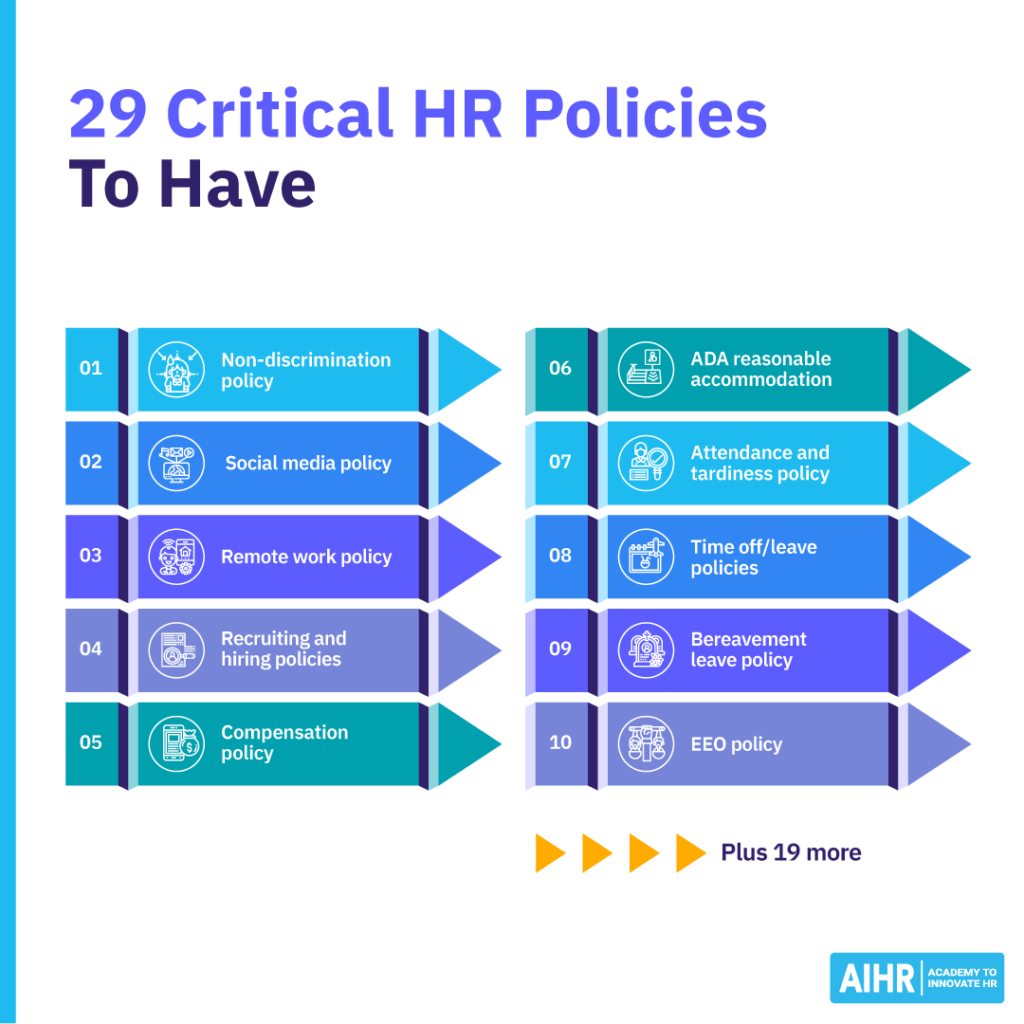
3. Anti-harassment policy
An anti-harassment policy is crucial to maintaining a safe and comfortable work environment. Harassment can be defined as any unwelcome conduct that violates an individual’s dignity or generates an intimidating, hostile, degrading, humiliating, or offensive environment. This behavior can be demonstrated physically or verbally and in either a sexual or non-sexual manner.
The anti-harassment policy should provide guidelines on the reporting of harassment to HR. It is also essential for HR teams to make sure employees feel comfortable reporting harassment and that they investigate any claims and allegations seriously and appropriately.
4. Retaliation policy
Retaliation is a term that refers to any adverse action taken by an employer against an employee who has reported a violation of workplace policies or laws. Forms of retaliation can include termination or dismissal, exclusion or isolation, hostile work environment, failing to promote, or any other discriminatory treatment.
Some countries’ laws prohibit employers from retaliating against their employees. Employees who feel they have been retaliated against can take advantage of various reporting options, such as filing a complaint with Human Resources or taking legal action in a court of law.
HR must have a retaliation policy in place to protect employees who exercise their rights and responsibilities within the workplace and promote ethical workplace behavior. Enforcing such policies can help promote a safe and fair work environment for everyone involved.
5. Social media policy
Social media has become an integral part of business and many people’s personal lives. However, companies need to create and enforce social media policies that protect the reputation of the company and provide guidance for company accounts.
In research conducted by the Pew Research Center, around half of all full-time and part-time workers (51%) stated that their workplace enforces rules on social media usage while working. Additionally, 32% of workers indicated that their employers have guidelines on how employees should present themselves on the Internet as a whole, with 63% indicating that their employer does not enforce such policies.
Ultimately, social media policies can help prevent negative impacts on the company’s reputation and safeguard against legal liabilities that may arise. Having a clear and concise social media policy lets employees better understand how to represent the company on social media platforms, allowing for a positive and engaging online presence.
6. Work-from-home policy
Numerous organizations have embraced hybrid or fully remote working arrangements. For those who have, it is crucial to establish a comprehensive telecommuting policy that conveys guidelines for these situations and helps sustain consistency, company culture, and employee productivity.
A work-from-home policy should facilitate efficient work by establishing clear expectations regarding the frequency of working from home and the need to be in the office. It should also address the needs of remote and hybrid workers, such as preventing burnout.
According to a study conducted by Buffer, 63% of remote workers feel compelled to check emails on weekends, with 34% doing so even while on vacation. An additional 48% indicated that they often work outside of traditional work hours.
Microsoft emphasizes work-life balance by encouraging teams to set boundaries while working from home, limit meetings to 30 minutes, and take regular breaks to step away from tasks and electronic devices during work hours.
7. International remote work policy
Employers that allow telecommuting need to consider whether this includes remote work from abroad. Even if data security and time difference are not issues, there are legal and tax implications when employees are residents of another country.
The University of Washington’s international remote work policy allows academic personnel to work from countries where it has a registered legal presence. Remote working from other countries is prohibited.
Generally, an employment relationship is subject to the country’s laws where employees perform their jobs. This can mean a corporate tax liability and that an employer’s termination policy and benefits may not meet the same standards as local regulations. Some countries may also have immigration laws that prohibit residents from working for an organization headquartered overseas.
It is critical for organizations that enable employees to “work from anywhere” to implement an international remote work policy It should cover the legal and tax implications, as well as requirements and guidelines for employees, such as:
- Application and approval process steps
- Legal and tax obligations for employees
- Included and excluded countries
- Limit on how long employees can be located abroad
- Protocols for maintaining communication.
8. Workplace violence policy
A workplace violence policy is an essential component of any well-functioning organization. It is paramount to institute a zero-tolerance approach to the issue. Equally important is defining what constitutes instances of workplace violence and what items are classified as weapons.
Prohibited behaviors and the potential disciplinary measures for violating the policy should be clearly outlined. A comprehensive workplace violence policy helps ensure employees’ safety and wellbeing and creates a healthy and productive working environment.
9. Drug and alcohol policy
A drug and alcohol policy is essential to any workplace safety program. It establishes the rules and expectations regarding substance use and abuse among employees. The policy must specify the procedures for testing, which may include random testing, post-incident testing, and reasonable suspicion testing. Consequences for violating the policy should also be distinctly outlined.
Depending on the industry, additional policies may be necessary. For instance, commercial drivers and other Department of Transportation-enforced workers may have special considerations for their circumstances to ensure the safety of everyone involved.
10. Recruiting and hiring policies
Recruiting and hiring policies serve as guiding principles while hiring the most suitable candidates for specific job roles. Hiring and selection policies should be carefully designed, with detailed guidelines, to support the organization’s attempt to employ candidates whose education, experience, and skills match the job requirements.
In addition to this, document retention policies play a crucial role in maintaining complete employment records after the hiring process is complete. By documenting the hiring process and retaining the relevant documents for future reference, employers can sustain both legal compliance and a smooth onboarding experience for new employees.
11. Compensation policy
A compensation policy defines how an organization structures employee pay. It outlines different classifications, such as full-time, part-time, exempt, and non-exempt employees, and explains how these classifications are determined.
Including guidelines on supplemental workers—such as temporary employees and contractors—can also be valuable, along with the approval process for hiring them. This is especially relevant as the use of freelancers and contractors continues to rise. According to Forbes Advisor, 35% of the workforce now consists of independent workers.
The policy should also clarify how various pay components are determined, including salaries, benefits, internal equity, overtime pay, bonuses, merit increases, per diem, hazard pay, etc.
Ultimately, a well-defined compensation policy provides a structured approach to employee pay, ensuring fairness, consistency, and transparency.
12. Workplace health and safety/injury reporting policy
This type of policy defines the organization’s safety and emergency policies and procedures, specifying any legal or safety regulations that may apply to certain workplace hazards.
It should also establish the expectation that employees report all work-related injuries or safety concerns promptly, ensuring a safe and compliant work environment.
13. ADA reasonable accommodation
The Americans with Disabilities Act (ADA) requires employers to provide reasonable accommodations to ensure equal employment opportunities for job applicants and employees with disabilities.
This policy should define what qualifies as a reasonable accommodation under the law and outline the steps for requesting one. It should also explain how the company reviews, approves, or denies requests, covering both hiring processes and job duty adjustments.
14. Religious accommodation policy
Ensuring equal treatment in the workplace includes providing reasonable religious accommodations when needed. Employees who require adjustments due to their religious beliefs or practices should clearly understand how to request them.
Under U.S. law, employees are entitled to request religious accommodation, and HR is responsible for reviewing these requests to determine if they are reasonable and practical. The policy should outline the request process, which may include submitting a formal request form, meeting with HR or a supervisor, and providing any necessary documentation.
A clear religious accommodation policy helps create an inclusive workplace while ensuring compliance with legal requirements.
15. Discipline policies
A structured disciplinary process ensures fairness and consistency when addressing employee misconduct. This policy should outline the levels of disciplinary action, their duration, and the documentation required at each stage.
It should also include clear procedures for notifying employees of disciplinary actions and provide an appeals process, allowing employees to challenge decisions they believe are unjust.
16. Dress code policy
A dress code policy sets expectations for workplace attire, whether requiring specific uniforms or providing general guidelines on appropriate dress. These standards may apply both on company premises and in external settings where employees represent the organization.
The policy should be clear, respectful, and non-discriminatory, with flexibility to accommodate religious and cultural differences.
17. Attendance and tardiness policy
This type of HR policy outlines the steps an employee should take when they have an unscheduled or scheduled absence, as well as what to do if they are running late for work. Outline expectations for reporting to work on time and notification process for tardiness or absence.
Proper attendance policies, with clearly defined consequences for excessive unexcused absenteeism and tardiness, help employees understand the importance of being present and making a contribution that ensures the organization can function properly.
18. Time off/leave policies
Employees need to understand how to request extended time off for various reasons, such as personal leave, sick leave, FMLA leave, military leave, and other absences. Not only does a comprehensive leave of absence policy aid in preparation for the employee’s absence and designating it as the appropriate type of leave, but it can also help reduce stress and uncertainty for employees who may be dealing with difficult situations.
19. Bereavement leave policy
Bereavement leave policies can be incorporated in your general leave policy section or as a separate entry for compassionate leave. Be sure to define how many bereavement days are available and provide a definition for “immediate family member” or any other terms that are open to interpretation.
20. Meals and break periods policy
Creating transparency about meals and break periods ensures employees are well-informed and can plan their workday efficiently.
Your policy should state the duration of meal and break periods and the number of breaks an employee is entitled to. Having a formal policy is not only good practice but also a legal obligation for some industries.
21. Nepotism policy
A nepotism policy prevents favoritism that can occur when family or personal relationships exist in an organization. It can address the following:
- A definition of nepotism and covered relationships (e.g., spouses/romantic, siblings, parents/children)
- Potential conflicts of interest
- Types of situations involving relatives that are permitted or prohibited
- Process for hiring family members within the same department, organization, or reporting structure
- Consequences for violating the policy.
Nepotism policies typically forbid employees from directly supervising someone they are in a family or close personal relationship with. This reinforces a merit-based workplace where certain employees don’t receive special treatment because of their personal connections.
22. Work authorization/immigration policy
Employers must comply with laws governing employment eligibility. This policy should outline the legal requirements for verifying employee identity and work authorization, including how new hires provide evidence of their eligibility.
In the U.S., employers are required to verify the work authorization of every employee, regardless of whether they are a U.S. citizen or not. This means having a Form I-9 on file for every new hire and supporting documentation of identity and work eligibility.
The policy may also address whether the organization sponsors foreign worker visas and any responsibilities non-citizen employees have in maintaining their status.
23. Equal Opportunity Employer policy
An equal opportunity employer policy confirms the company’s commitment to complying with the U.S. federal laws enforced by the Equal Employment Opportunity Commission (EEOC), which prohibit discrimination against job candidates or employees based on protected characteristics such as:
- Race
- Sex (including sexual orientation, pregnancy, and gender identity)
- Age
- Religion
- Disability
- National origin
- Genetic information.
24. Electronic communications policy
The purpose of an electronic communications policy is to govern digital interactions with electronic resources that are used within the organization to protect sensitive information, maintain professionalism, and mitigate risks.
It should present expectations, acceptable practices, compliance requirements, and security measures for using tools such as email, IM programs, voice mail, confidential electronic records, etc. Clarify that the organization has the right to monitor the use of any company property, which includes computers, internet usage, etc.
25. Employee resource group policy
An employee resource group policy formalizes the purpose, structure, and functions of employee resource groups (ERGs). It should outline:
- How ERGs can be established
- Their objectives and funding process
- Membership and leadership criteria
- Restrictions on certain groups or causes.
Along with a company-wide policy, each ERG should have its own policy or charter that covers areas such as its mission, membership requirements, participation expectations, etc.
26. Generative AI policy
Generative AI, such as Chat GPT and other artificial intelligence chatbots, are widely used in business operations and by employees to streamline their duties. Although very helpful, these tools are not without their drawbacks and risks. Each organization needs a proactive generative AI policy to ensure internal accountability for ethical AI use and compliance with applicable laws.
This policy should include principles for the responsible use of generative AI, which privacy laws are at play, how systems will be monitored, and how the data produced will be managed.
27. Termination policy
Ending an employment relationship can be complex. A comprehensive termination policy is a key obligation for every organization. It structures the process, maintains consistency, manages expectations, treats employees fairly, and prevents conflict and legal complications.
The policy should describe the following:
- Categories of employment termination (i.e., voluntary, involuntary, contract expiration)
- Required notice periods
- Causes for involuntary termination
- Steps in the termination process
- Post-termination/offboarding procedures.
28. Employee sabbatical policy
Certain organizations offer employees extended time off with the assurance that they can return to their jobs. Employees take advantage of this sabbatical leave to pursue academic study, travel, or focus on their personal lives.
Organizations that provide this benefit must have an employee sabbatical policy to establish the rules.
The policy should contain the following elements:
- Eligibility requirements
- Clarification of whether pay and benefits are included
- Minimum and maximum duration
- Frequency and limits on the number of sabbaticals
- Application and approval process
- Conduct expectations during leave
- Return-to-work procedures.
29. Code of conduct policy
A code of conduct policy outlines expected behaviors and ethical standards for employees, ensuring professionalism, integrity, and compliance with company values and legal requirements.
This policy typically covers professional behavior, confidentiality, conflicts of interest, and compliance with laws. It also includes guidelines on anti-discrimination, workplace integrity, appropriate use of company resources, and dress code expectations.
Violations may result in disciplinary action, including warnings, suspension, or termination. A well-defined code of conduct fosters accountability and a positive work environment.
How to write an HR policy
You may be creating a list of HR policies to proactively guide and protect the company and its employees or to address a specific issue. In either case, developing clear, well-structured policies ensures consistency, compliance, and effective problem-solving in the workplace.
Here are some best practices to keep in mind when drafting HR policies for employees:
- Seek input: Engage with colleagues, managers, and other stakeholders for their insight into the work situations that the policy pertains to. This will keep it relevant and realistic. You can even approach external professionals for their advice on policy wording that has worked well for their organizations. Don’t forget to thoroughly research updates to any laws and regulations that govern a policy. (Be sure to get approval from in-house or external legal counsel before finalizing any HR policy.)
- Establish clear language: HR policies must be written in simple, straightforward language to ensure all employees can understand them. Ambiguous or overly complex wording can lead to confusion, inconsistent interpretation, and potential legal risks. Clear communication helps employees know what is expected of them, promotes consistency in policy enforcement, and reduces the likelihood of misunderstandings.
HR tip
Ensure command words in each policy convey the correct meaning. For instance:
“Must” signals a required action.“Will” can have two meanings – a mandatory action or a foreseen action.“Should” and “may” are not strong commands. They indicate that someone may choose not to act.
- Provide examples: Providing examples within policies can reinforce consistency in interpretation and implementation. For example, if the policy states that employees must take their vacation days within a certain period of time, provide an example of what this might look like in practice (e.g., “Employees must take their vacation time within 12 months of earning it.”)
- Use resources: There are many resources to refer to when drafting policies. Organizations such as the Society for Human Resources (“SHRM”), Indeed, and LinkedIn contain helpful information, as well as HR policy examples and templates. AIHR also offers an extensive library of resources you can use as a starting point for writing HR policies.
- Coordinate similar policies: Identify overlapping policies to ensure consistency in language and enforcement. For example, sexual harassment may be addressed in both discrimination and harassment policies. Aligning the wording and requirements prevents contradictions that could confuse employees, create enforcement challenges, or lead to legal risks.
- Allow flexibility: Policies are usually written in more general terms. This means they can’t cover every possible scenario that could potentially fall under the policy. This allows for some flexibility in policy interpretation to accommodate extenuating circumstances. Questions on interpreting a policy or identifying policy precedents should be directed to the Human Resources department.
- Factor in the employee experience: Consider how policies impact employees and whether they contribute to a positive work environment. Policies should be fair, practical, and supportive of employee wellbeing while balancing organizational needs.
HR tip
Simplify access to additional information by adding links to any web pages or documents referenced in a policy.
Essential elements of an HR policy
The main components to include in HR policies are as follows:
- Purpose: Explains why the policy is necessary and its intended objectives.
- Policy statement: Defines the organization’s stance or rules regarding the subject.
- Scope: Specifies who the policy applies to (e.g., all employees, specific departments, full-time vs. part-time, etc.).
- Actions and responsibilities: Outlines what is required of employees, managers, HR, and other stakeholders.
- Enforcement and consequences: Describes how the policy will be enforced and the consequences of non-compliance.
- Definitions: Clarifies any terms that may not be self-explanatory.
- Policy owner: Identifies the person or department responsible for enforcing and maintaining the policy.
- Related procedures: Details any steps employees and management must follow to comply with the policy.
- Effective date: States when the policy goes into effect.
- Review date: Indicates when the policy was last reviewed or updated.
- Approval: Specifies who has authorized the policy.
- Accessibility: Ensures employees can easily access policies, whether through an employee handbook, intranet, or training sessions
A final word
HR policies are integral to an organization’s overall operations and HR strategy. They provide the workforce with a roadmap for navigating employment-related issues, opportunities, and challenges. They also help the company mitigate risks and avoid legal challenges.
HR must be proactive in developing policies and updating them as needed based on any changes in the law and the company initiatives and environment.
Policies are only effective if employees are aware of them. It’s the company’s responsibility to communicate and train the workforce on its policies. Then employees understand what’s expected of them, what their rights are, and how to navigate policy options and procedures.
FAQ
HR policies define expectations, set guidelines for handling employment-related issues, and establish clear parameters for workplace conduct. They also help mitigate legal risks by ensuring compliance with labor laws and company standards.
There are many federal laws that policies must address, such as discrimination, harassment, hostile work environment, ADA, and FMLA, just to name a few. State-specific requirements vary, so companies must determine which state laws necessitate formal policies. Additionally, policies should be regularly updated to reflect legal changes. The company’s size can also influence which policies are legally required.
Core HR policies typically cover legally required guidelines along with key areas like time off (sick leave, vacation, leave of absence), disciplinary actions, and compensation. The specific policies in place will depend on the company’s size, industry, and location. These guidelines should be regularly reviewed, updated as needed, and easily accessible to employees.
Learn more
Related articles
Are you ready for the future of HR?
Learn modern and relevant HR skills, online







